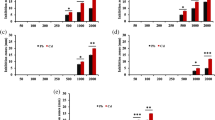Abstract
The dietary intake of lead (Pb) via contaminated food and drinking water possesses a serious risk to human health. In this study, the Pb2+ binding ability of 25 lactic acid bacteria strains was investigated, and the strain with the highest binding property, Lactobacillus plantarum CCFM8661 (36.66 ± 1.01 %), was selected for further study. The results of electron microscope revealed that most of Pb2+ was bound on the surface of bacterial cells and small amount of Pb2+ was observed in the cells. The comparison of the binding ability of different cellular components also demonstrated that the cell walls (73.79 ± 0.31 %) play a significant role in the Pb2+ binding. Through the study of the binary metals systems, the results showed that L. plantarum CCFM8661 still preferred to bind Pb2+ at the presence of other cations such as Fe2+ and Zn2+. The binding process was well explained by the Langmuir isotherm model (R 2 = 0.97), the Langmuir–Freundlich dual isotherm model (R 2 = 0.99), and the pseudo-second-order kinetic model (R 2 = 0.99).





Similar content being viewed by others
References
Liu H, Probst A, Liao B (2005) Metal contamination of soils and crops affected by the Chenzhou lead/zinc mine spill (Hunan, China). Sci Total Environ 339(1–3):153–166
Newton K, Amarasiriwardena D, **ng B (2006) Distribution of soil arsenic species, lead and arsenic bound to humic acid molar mass fractions in a contaminated apple orchard. Environ Pollut 143(2):197–205
Zheng N, Wang Q, Zhang X, Zheng D, Zhang Z, Zhang S (2007) Population health risk due to dietary intake of heavy metals in the industrial area of Huludao City, China. Sci Total Environ 387(1–3):96–104
Jomova K, Valko M (2011) Advances in metal-induced oxidative stress and human disease. Toxicology 283(2–3):65–87
Ikeda M, Zhang ZW, Shimbo S, Watanabe T, Nakatsuka H, Moon CS, Matsuda-Inoguchi N, Higashikawa K (2000) Urban population exposure to lead and cadmium in east and south–east Asia. Sci Total Environ 249(1–3):373–384
Sisombath NS, Jalilehvand F, Schell AC, Wu Q (2014) Lead(II) binding to the chelating agent d-penicillamine in aqueous solution. Inorg Chem 53(23):12459–12468
Chang JS, Law R, Chang CC (1997) Biosorption of lead, copper and cadmium by biomass of Pseudomonas aeruginosa PU21. Water Res 31(7):1651–1658
Das SK, Das AR, Guha AK (2007) A study on the adsorption mechanism of mercury on Aspergillus versicolor biomass. Environ Sci Technol 41(24):8281–8287
Wang JL (2002) Biosorption of copper(II) by chemically modified biomass of Saccharomyces cerevisiae. Process Biochem 37(8):847–850
Teemu H, Seppo S, Jussi M, Raija T, Kalle L (2008) Reversible surface binding of cadmium and lead by lactic acid and bifidobacteria. Int J Food Microbiol 125(2):170–175
Ibrahim F, Halttunen T, Tahvonen R, Salminen S (2006) Probiotic bacteria as potential detoxification tools: assessing their heavy metal binding isotherms. Can J Microbiol 52(9):877–885
Polak-Berecka M, Szwajgier D, Wasko A (2014) Biosorption of Al+3 and Cd+2 by an Exopolysaccharide from Lactobacillus rhamnosus. J Food Sci 79(11):T2404–T2408
Henriques B, Rocha LS, Lopes CB, Figueira P, Monteiro RJR, Duarte AC, Pardal MA, Pereira E (2015) Study on bioaccumulation and biosorption of mercury by living marine macroalgae: prospecting for a new remediation biotechnology applied to saline waters. Chem Eng J 281:759–770
Limcharoensuk T, Sooksawat N, Sumarnrote A, Awutpet T, Kruatrachue M, Pokethitiyook P, Auesukaree C (2015) Bioaccumulation and biosorption of Cd2+ and Zn2+ by bacteria isolated from a zinc mine in Thailand. Ecotox Environ Safe 122:322–330
Srinath T, Verma T, Ramteke PW, Garg SK (2002) Chromium (VI) biosorption and bioaccumulation by chromate resistant bacteria. Chemosphere 48(4):427–435
Stoll A, Duncan JR (1996) Enhanced heavy metal removal from waste water by viable, glucose pretreated Saccharomyces cerevisiae cells. Biotechnol Lett 18(10):1209–1212
Smiejan A, Wilkinson KJ, Rossier C (2003) Cd bioaccumulation by a freshwater bacterium, Rhodospifillum rubrum. Environ Sci Technol 37(4):701–706
Slaveykova VI, Wilkinson KJ (2002) Physicochemical aspects of lead bioaccumulation by Chlorella vulgaris. Environ Science Technol 36(5):969–975
Halttunen T, Salminen S, Tahvonen R (2007) Rapid removal of lead and cadmium from water by specific lactic acid bacteria. Int J Food Microbiol 114(1):30–35
Tian F, Zhai Q, Zhao J, Liu X, Wang G, Zhang H, Zhang H, Chen W (2012) Lactobacillus plantarum CCFM8661 Alleviates Lead Toxicity in Mice. Biol Trace Elem Res 150(1–3):264–271
Halttunen T, Collado MC, El-Nezami H, Meriluoto J, Salminen S (2008) Combining strains of lactic acid bacteria may reduce their toxin and heavy metal removal efficiency from aqueous solution. Lett Appl Microbiol 46(2):160–165
Chakravarty R, Banerjee PC (2008) Morphological changes in an acidophilic bacterium induced by heavy metals. Extremophiles 12(2):279–284
Chakravarty R, Banerjee PC (2012) Mechanism of cadmium binding on the cell wall of an acidophilic bacterium. Bioresour Technol 108:176–183
Zhao H, Zhou F, Qi Y, Dziugan P, Bai F, Walczak P, Zhang B (2013) Screening of Lactobacillus strains for their ability to bind benzo(a)pyrene and the mechanism of the process. Food Chem Toxicol 59:67–71
Gopal PK, Reilly KI (1995) Molecular architecture of the lactococcal cell surface as it relates to important industrial properties. Int Dairy J 5(8):1095–1111
Sun F, Shao Z (2007) Biosorption and bioaccumulation of lead by Penicillium sp. Psf-2 isolated from the deep sea sediment of the Pacific Ocean. Extremophiles 11(6):853–858
El-Sayed MT (2013) Removal of lead(II) by Saccharomyces cerevisiae AUMC 3875. Ann Microbiol 63(4):1459–1470
Puranik PR, Paknikar KM (1999) Influence of co-cations on biosorption of lead and zinc—a comparative evaluation in binary and multimetal systems. Bioresour Technol 70(3):269–276
Abdolali A, Huu Hao N, Guo W, Zhou JL, Du B, Wei Q, Wang XC, Phuoc Dan N (2015) Characterization of a multi-metal binding biosorbent: chemical modification and desorption studies. Bioresour Technol 193:477–487
Nieboer E, Richardson DHS (1980) The replacement of the nondescript term `heavy metals’ by a biologically and chemically significant classification of metal ions. Environ Pollut 1(1):3–26
Langmuir I (1918) The Adsorption of gases on plane surfaces of glass, mica and platinum. J Am Chem Soc 40(9):1361–1403
Freundlich HMF (1906) Über die Adsorption in Lösungen. Z Phys Chem 57A:385–470
Chatterjee S, Das SK, Chakravarty R, Chakrabarti A, Ghosh S, Guha AK (2010) Interaction of malathion, an organophosphorus pesticide with Rhizopus oryzae biomass. J Hazard Mater 174(1–3):47–53
Foo KY, Hameed BH (2010) Insights into the modeling of adsorption isotherm systems. Chem Eng J 156(1):2–10
Vijayaraghavan K, Yun Y-S (2008) Bacterial biosorbents and biosorption. Biotechnol Adv 26(3):266–291
Montazer-Rahmati MM, Rabbani P, Abdolali A, Keshtkar AR (2011) Kinetics and equilibrium studies on biosorption of cadmium, lead, and nickel ions from aqueous solutions by intact and chemically modified brown algae. J Hazard Mater 185(1):401–407
Vijayaraghavan K, Han MH, Choi SB, Yun YS (2007) Biosorption of Reactive black 5 by Corynebacterium glutamicum biomass immobilized in alginate and polysulfone matrices. Chemosphere 68(10):1838–1845
Majumdar SS, Das SK, Chakravarty R, Saha T, Bandyopadhyay TS, Guha AK (2010) A study on lead adsorption by Mucor rouxii biomass. Desalination 251(1–3):96–102
Acknowledgments
This work was supported by the National Natural Science Foundation of China Key Program (No. 31530056), the National Science Fund for Distinguished Young Scholars (No. 31125021), the National Natural Science Foundation of China General Program (No. 31470161), the Science and Nature Foundation of Jiangsu Province (No. BK 20131102), the key projects in the National Science & Technology Pillar Program during the twelfth five-year plan period (Nos. 2012BAD12B02, 2012BAD28B08), the National Basic Research Program of China (973 Program No. 2012CB720802), the 111 Project B07019, and the Program for Changjiang Scholars and Innovative Research Team in University (IRT1249) and Young Foundation of Jiangnan University (No. JUSRP115A23). The funders had no role in study design, data collection and analysis, decision to publish, or preparation of the manuscript.
Author information
Authors and Affiliations
Corresponding authors
Ethics declarations
Conflict of interest
The authors declare that they have no conflict of interest.
Compliance with ethics requirements
This article does not contain any studies with human or animal subjects.
Additional information
Ruijie Yin and Qixiao Zhai have contributed equally to this work.
Electronic supplementary material
Below is the link to the electronic supplementary material.
Rights and permissions
About this article
Cite this article
Yin, R., Zhai, Q., Yu, L. et al. The binding characters study of lead removal by Lactobacillus plantarum CCFM8661. Eur Food Res Technol 242, 1621–1629 (2016). https://doi.org/10.1007/s00217-016-2661-9
Received:
Revised:
Accepted:
Published:
Issue Date:
DOI: https://doi.org/10.1007/s00217-016-2661-9




